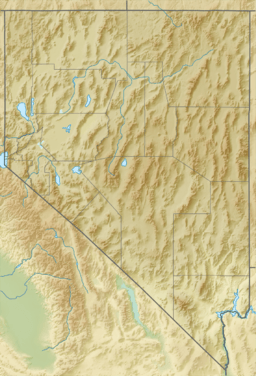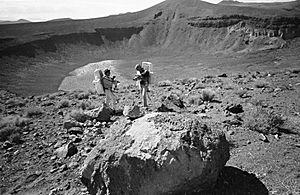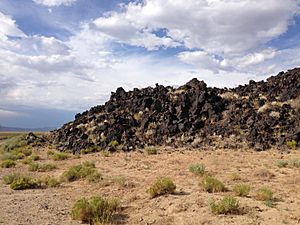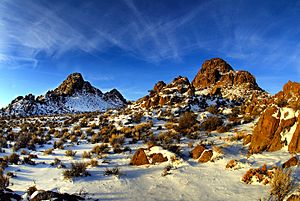Lunar Crater volcanic field facts for kids
Quick facts for kids Lunar Crater volcanic field |
|
|---|---|
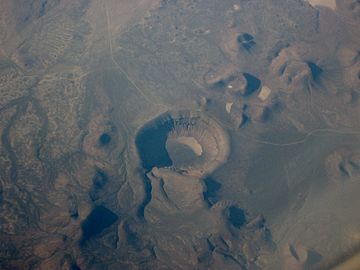
Aerial view of Lunar Crater and surrounding vents
|
|
| Highest point | |
| Elevation | 2,255 m (7,398 ft) |
| Geography | |
| Geology | |
| Last eruption | 38,100 ± 10,000 years ago |
The Lunar Crater volcanic field is a special area in Nye County, Nevada, where many volcanoes are found. It's located near the Reveille Range and Pancake Range mountains. This field has over 200 volcanic openings, mostly small cone-shaped volcanoes with lava that flowed out. There are also some wide, flat craters called maars, including the famous Lunar Crater itself.
Over time, some of these volcanic spots have worn down, showing the rock structures underneath. The main Lunar Crater has even been used to test Mars rovers and train astronauts for space missions!
This volcanic field sits on top of much older volcanic rocks and huge craters called calderas. But the volcanoes we see today only started forming about 6 million years ago. Scientists are still trying to figure out exactly why there's so much volcanic activity here. The volcanoes have produced different kinds of basaltic lava. The most recent eruption happened about 38,000 years ago, and new eruptions could still happen.
Contents
Why is it called Lunar Crater?
The volcanic field gets its name from the Lunar Crater, which is the most unique crater in the area. This region is very dry and rugged, so not many people live there.
Because of its interesting geology and easy access, the Lunar Crater volcanic field was chosen for important tests. It was used to test early Mars rovers, which are robots that explore Mars. It also served as a training ground for astronauts who were preparing for the Moon landings.
Some parts of the volcanic field are protected within the Palisade Mesa wilderness study area. The Lunar Crater itself is a special place called a National Natural Landmark.
Where is the Lunar Crater volcanic field?
The Lunar Crater volcanic field is located in Nye County, in the middle of Nevada. It's about 100 kilometers (62 miles) east-northeast of Tonopah and 400 kilometers (250 miles) north of Las Vegas.
Two highways, Nevada State Route 375 and U.S. Route 6, pass through the volcanic field. It's about halfway between Tonopah and Ely along Route 6. There are also dirt roads that go through the area. You can find parking spots at the Easy Chair crater and on the edge of Lunar Crater.
What does the area look like?
The volcanic field stretches for about 80 kilometers (50 miles) long and 10-20 kilometers (6-12 miles) wide. It covers an area of about 1,000 square kilometers (386 square miles). It runs from north-northeast to south-southwest, between the Reveille Range and Pancake Range mountains.
There are over 200 volcanic openings here. Most are monogenetic volcanoes, which means they erupted only once. These volcanoes have lava flows that are 1 to 10 kilometers (0.6 to 6 miles) long. There are also a few lava domes, dykes (magma intrusions), four maars (craters formed by gas explosions), scoria cones, and tuff rings. The cones can be up to 200 meters (656 feet) tall and 1,200 meters (3,937 feet) wide.
Over time, erosion has changed some of the volcanoes. Some have become flat-topped hills called mesas. Older volcanoes have also developed soil and drainage systems.
A dry lakebed called the Lunar Lake playa is in the northern part of the volcanic field. It's at an elevation of 1,750 meters (5,741 feet). Water collects here from local streams, but only for short periods.
Famous volcanoes in the field
The Lunar Crater itself is almost perfectly round. It's about 1,100 meters (3,609 feet) wide and 130 meters (426 feet) deep. It's the lowest point in this volcanic field. The crater is surrounded by volcanic material like ash and scoria.
The Marcath cone, also known as Black Rock, is very well preserved. It's only a few kilometers north of U.S. Route 6. This cone is about 150 meters (492 feet) high and 500 by 900 meters (1,640 by 2,952 feet) wide. It formed over a crack in the ground. Lava flows from its western side, reaching several kilometers long.
The Kimana volcano, which means "butterfly" in Shoshone, is an eroded volcano. It's made of lava flows and pyroclastic deposits (volcanic rock fragments). These cover an area of 26 square kilometers (10 square miles).
Easy Chair is a ridge about 240 meters (787 feet) high and 2.5 kilometers (1.5 miles) long. It's made of volcanic material that erupted from a crack. It also has two scoria cones and a maar.
Bea's Crater is another maar, located southeast of Marcath volcano. It's a complex crater with two overlapping parts, about 440 meters (1,443 feet) and 1,050 meters (3,444 feet) wide. It can be up to 147 meters (482 feet) deep.
Dark Peak is an older volcano where you can see its underground structure. A dyke, which is a steep, flat intrusion of magma, is exposed here.
How the volcanoes formed
Why volcanoes are here
Volcanoes that form away from plate boundaries are found in many parts of the Western United States. This includes areas like the Sierra Nevada mountains and the Basin and Range province. The Lunar Crater volcanic field is in the Basin and Range province, but it's in a very central spot.
Scientists think that hot rock from deep inside the Earth's mantle might be rising up here. This could be causing the volcanic activity. The Earth's crust in this area is quite thin, only about 30-33 kilometers (18-20 miles) thick. It sits on top of a very hot mantle.
The Lunar Crater volcanic field is part of a larger volcanic zone that stretches south towards Death Valley, California. This zone is called the "Death Valley-Pancake Range basalt zone."
Older rocks and faults
Older volcanic activity happened in this area about 24 million years ago. This created huge craters called calderas, like the Central Nevada Caldera Complex. The Lunar Lake caldera, for example, lies beneath much of the northern Lunar Crater volcanic field. These older eruptions produced different types of lava and ash.
These older volcanic rocks also form the basement (the underlying rock) of the area. Some parts are covered by alluvium, which is sediment carried by water. Even older rocks from the Paleozoic era (about 541 to 252 million years ago) are found at the edge of the volcanic field.
Many of the volcanoes in the Lunar Crater field seem to be located along faults. Faults are cracks in the Earth's crust where rocks have moved. These faults have also affected the older volcanoes in the area. The volcanic activity has covered many of these faults, so there isn't much evidence of them moving today.
What the rocks are made of
The volcanoes in the Lunar Crater field have erupted alkali basalts. These are a type of lava that comes from deep within the Earth's mantle. The rocks often contain visible crystals called phenocrysts.
The magma (molten rock) seems to come from different parts of the mantle. It rises quickly to the surface without staying in large, long-lasting magma chambers. Each volcano was fed by its own batch of magma.
Climate and plants
The climate here is continental and very dry. It gets about 12 centimeters (4.7 inches) of rain each year. The average temperature is about 12°C (53°F). Temperatures can reach 32°C (90°F) in summer and drop to -8°C (17°F) in winter.
There isn't much plant life. It's mostly a sagebrush steppe (a dry grassland). You'll find bushes like greasewood and saltbrush, with grasses like Indian ricegrass underneath. The Lunar Crater is also the only place where a special plant called "Lunar Crater Howell's-buckwheat" (Johanneshowellia crateriorum) is found.
History of eruptions
The volcanic field has been active for a long time, with the oldest eruptions happening about 6 million years ago. Volcanic activity happened in four main stages, with peaks every 1-2 million years. The older volcanoes are in the south, while more recent eruptions happened farther north. This means that volcanism has slowly moved north over time.
Scientists have dated many eruptions in the Lunar Crater volcanic field. They use methods like radiometric dating and also look at how much the volcanoes have been worn down by weather and erosion. Older volcanoes are often more degraded and covered by soil.
- Kimana volcano is probably about 5.7 million years old.
- The Qc cone erupted about 1.61 million years ago.
- Easy Chair is about 140,000 years old.
The exact age of Lunar Crater itself isn't known for sure, but it's thought to be between 190,000 and 72,000 years old. Bea's Crater might be between 300,000 and 100,000 years old.
Eruptions often started with explosive eruptions that formed mounds. Then, effusive eruptions (where lava flows out) created lava flows. The eruptions were similar to Hawaiian or Strombolian eruptions. Maars and tuff rings formed when rising magma mixed with groundwater. Volcanic cones formed when material from the volcano piled up.
Most recent eruption and future risks
The most recent eruption happened about 38,000 years ago. This formed the Marcath (or Black Rock) unit. Because there has been recent activity, future eruptions are possible. This means the volcanic field could be considered active.
Eruptions that form scoria cones can be dangerous. They can throw out large rocks and create lava flows. Volcanic ash and dust can also disrupt air traffic. Even though these eruptions are usually small, they can still cause problems.


